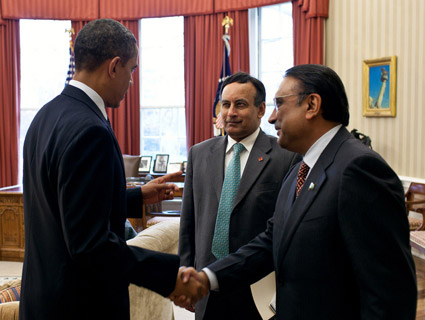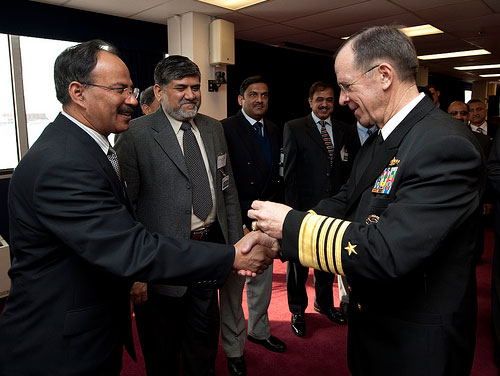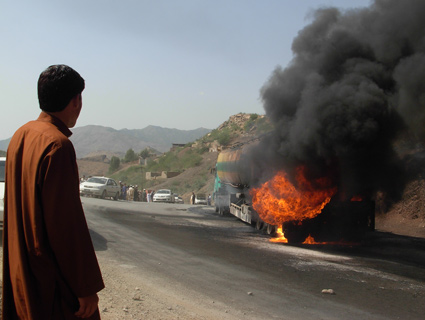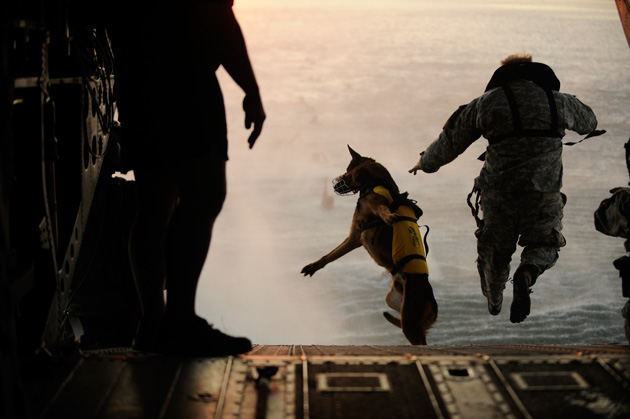
President Obama meets with President Asif Ali Zardari of Pakistan and Husain Haqqani, Pakistan's ambassador to the US, in the Oval Office in January 2011.<a href="http://www.flickr.com/photos/whitehouse/5434726954/">The White House</a>/Flickr
This story first appeared on the TomDispatch website.
The following ingredients should go a long way to produce a political thriller. Mr. M, a jihadist in an Asian state, has emerged as the mastermind of a terrorist attack in a neighboring country, which killed six Americans. After sifting through a vast cache of intelligence and obtaining a legal clearance, the State Department announces a $10 million bounty for information leading to his arrest and conviction. Mr. M promptly appears at a press conference and says, “I am here. America should give that reward money to me.”
![]() A State Department spokesperson explains lamely that the reward is meant for incriminating evidence against Mr. M that would stand up in court. The prime minister of M’s home state condemns foreign interference in his country’s internal affairs. In the midst of this imbroglio, the United States decides to release $1.18 billion in aid to the cash-strapped government of the defiant prime minister to persuade him to reopen supply lines for US and NATO forces bogged down in the hapless neighboring Islamic Republic of Afghanistan.
A State Department spokesperson explains lamely that the reward is meant for incriminating evidence against Mr. M that would stand up in court. The prime minister of M’s home state condemns foreign interference in his country’s internal affairs. In the midst of this imbroglio, the United States decides to release $1.18 billion in aid to the cash-strapped government of the defiant prime minister to persuade him to reopen supply lines for US and NATO forces bogged down in the hapless neighboring Islamic Republic of Afghanistan.
Alarmingly, this is anything but fiction or a plot for an upcoming international sitcom. It is a brief summary of the latest development in the fraught relations between the United States and Pakistan, two countries locked into an uneasy embrace since September 12, 2001.
Mr. M. is Hafiz Muhammad Saeed, a 62-year-old former academic with a tapering, hennaed beard, and the founder of the Lashkar-e Taiba (the Army of the Pure, or LeT), widely linked to several outrageously audacious terrorist attacks in India. The LeT was formed in 1987 as the military wing of the Jammat-ud Dawa religious organization (Society of the Islamic Call, or JuD) at the instigation of the Pakistani army’s formidable intelligence agency, Inter-Services Intelligence (ISI). The JuD owes its existence to the efforts of Saeed, who founded it in 1985 following his return to his native Lahore after two years of advanced Islamic studies in Riyadh, Saudi Arabia, under the guidance of that country’s Grand Mufti, Shaikh Abdul Aziz bin Baz.
On its formation, the LeT joined the seven-year-old anti-Soviet jihad in Afghanistan, an armed insurgency directed and supervised by the ISI with funds and arms supplied by the CIA and the Saudis. Once the Soviets withdrew from Afghanistan in 1989, the Army of the Pure turned its attention to a recently launched anti-Indian jihad in Indian-administered Kashmir and beyond. The terrorist attacks attributed to it range from the devastating multiple assaults in Mumbai in November 2008, which resulted in 166 deaths, including those six Americans, to a foiled attack on the Indian Parliament in New Delhi in December 2001, and a successful January 2010 attack on the airport in Kashmir’s capital Srinagar.
In January 2002, in the wake of Washington’s launching of the Global War on Terror, Pakistan formally banned the LeT, but in reality did little to curb its violent cross-border activities. Saeed remains its final authority. In a confession, offered as part of a plea bargain after his arrest in October 2009 in Chicago, David Coleman Headley, a Pakistani-American operative of LeT involved in planning the Mumbai carnage, said: “Hafiz Saeed had full knowledge of the Mumbai attacks and they were launched only after his approval.”
 In December 2008, the United Nations Security Council declared the JuD a front organization for the banned LeT. The provincial Punjab government then placed Saeed under house arrest using the Maintenance of Public Order law. But six months later, the Lahore High Court declared his confinement unconstitutional. In August 2009, Interpol issued a Red Corner Notice, essentially an international arrest warrant, against Saeed in response to Indian requests for his extradition. Saeed was again put under house arrest but in October the Lahore High Court quashed all charges against him due to lack of evidence.
In December 2008, the United Nations Security Council declared the JuD a front organization for the banned LeT. The provincial Punjab government then placed Saeed under house arrest using the Maintenance of Public Order law. But six months later, the Lahore High Court declared his confinement unconstitutional. In August 2009, Interpol issued a Red Corner Notice, essentially an international arrest warrant, against Saeed in response to Indian requests for his extradition. Saeed was again put under house arrest but in October the Lahore High Court quashed all charges against him due to lack of evidence.
It is common knowledge that Pakistani judges, fearing for their lives, generally refrain from convicting high-profile jihadists with political connections. When, in the face of compelling evidence, a judge has no option but to order the sentence enjoined by the law, he must either live under guard afterwards or leave the country. Such was the case with Judge Pervez Ali Shah who tried Mumtaz Qadri, the jihadist bodyguard who murdered Punjab’s governor Salman Taseer for backing an amendment to the indiscriminately applied blasphemy law. Soon after sentencing Qadri to capital punishment last October, Shah received several death threats and was forced into self-exile.
Aware of the failures of the Pakistani authorities to convict Saeed, US agencies seemed to have checked and cross-checked the authenticity of the evidence they had collected on him before the State Department announced, on April 2nd, its reward for his arrest. This was nothing less than an implied declaration of Washington’s lack of confidence in the executive and judicial organs of Pakistan.
Little wonder that Pakistani Prime Minister Yousaf Raza Gilani took umbrage, describing the US bounty as blatant interference in his country’s domestic affairs. Actually, this is nothing new. It is an open secret that, in the ongoing tussle between Pakistani President Asif Ali Zardari and his bête noire, army chief of staff General Ashfaq Parvez Kayani, the Obama administration has always backed the civilian head of state. That, in turn, has been a significant factor in Gilani’s stay in office since March 2008, longer than any other prime minister in Pakistan’s history.
How to Trump a Superpower
Given such strong cards, diplomatic and legal, why then did the Obama administration commit itself to releasing more than $1 billion to a government that has challenged its attempt to bring to justice an alleged mastermind of cross-border terrorism?
The answer lies in what happened at two Pakistani border posts 1.5 miles from the Afghan frontier in the early hours of November 26, 2011. NATO fighter aircraft and helicopters based in Afghanistan carried out a two-hour-long raid on these posts, killing 24 soldiers. Enraged, Pakistan’s government shut the two border crossings through which the US and NATO had until then sent a significant portion of their war supplies into Afghanistan. Its officials also forced the US to vacate Shamsi air base, which was being used by the CIA as a staging area for its drone air war in Pakistan’s tribal areas along the Afghan border. The drone strikes are exceedingly unpopular – one poll found 97 percent of respondents viewed them negatively—and they are vehemently condemned by a large section of the Pakistani public and its politicians.
Furthermore, the government ordered a comprehensive review of all programs, activities, and cooperation arrangements with the US and NATO. It also instructed the country’s two-tier parliament to conduct a thorough review of Islamabad’s relations with Washington. Having taken the moral high ground, the Pakistani government pressed its demands on the Obama administration.
An appointed Parliamentary Committee on National Security (PCNS) then deliberately moved at a snail’s pace to perform the task on hand, while the Pentagon explored alternative ways of ferrying goods into Afghanistan via other countries to sustain its war there. By contrast, a vociferous campaign against the reopening of the Pakistani supply lines led by the Difa-e Pakistan Council (Defense of Pakistan), representing 40 religious and political groups, headed by Hafiz Saeed, took off. Its leaders have addressed huge rallies in major Pakistani cities. It was quick to condemn Washington’s bounty on Saeed, describing it as “a nefarious attempt” to undermine the Council’s drive to protect the country’s sovereignty.
Meanwhile, the loss of the daily traffic of 500 trucks worth of food, fuel, and weapons from the Pakistani port of Karachi through the Torkham and Chaman border crossings into Afghanistan, though little publicized in US media, has undermined the fighting capability of US and NATO forces.
“If we can’t negotiate or successfully renegotiate the reopening of ground lines of communication with Pakistan, we have to default and rely on India and the Northern Distribution Network (NDN),” said a worried Lieutenant General Frank Panter to the Readiness Subcommittee of the Armed Services Committee of the US House of Representatives on March 30th. “Both are expensive propositions and it increases the deployment or redeployment.”
The main part of the NDN is a 3,220-mile rail network for transporting supplies between the Latvian port of Riga and the Uzbek town of Termez (connected by a bridge over the Oxus River to the Afghan settlement of Hairatan). According to the Pentagon, it costs nearly $17,000 per container to go through the NDN compared to $7,000 through the Pakistani border crossings.
Moreover, US and NATO are allowed to transport only “non-lethal goods” through the NDN.
Other military officials have warned that the failure to reopen the Pakistani routes could even delay the schedule for withdrawing American “combat troops” from Afghanistan by 2014. That would be bad news for the Obama White House with the latest Washington Post/NBC News poll showing that, for the first time, even a majority of Republicans believe the Afghan War “has not been worth fighting.” A CBS News/New York Times survey indicated that support for the war was at a record low of 23 percent, with 69 percent of respondents saying that now was the time to withdraw troops.
In the Pakistani capital, Islamabad, the PCNS finally published a list of preconditions that the US must meet for the reopening of supply lines. These included an unqualified apology for the air strikes last November, an end to drone attacks, no more “hot pursuit” by US or NATO troops inside Pakistan, and the taxing of supplies shipped through Pakistan. Much to the discomfiture of the Obama administration, a joint session of the National Assembly and the Senate called to debate the PCNS report took more than two weeks to reach a conclusion.
On April 12th, the Parliament finally unanimously approved the demands and added that no foreign arms and ammunition should be transported through Pakistan. The Obama administration is spinning this development not as an ultimatum but as a document for launching talks between the two governments.
Even so, it has strengthened Prime Minister Gilani’s hand as never before. Furthermore, he has to take into account the popular support the Saeed-led Difa-e Pakistan Council is building for keeping the Pakistani border crossings permanently closed to NATO traffic. Thus, Saeed, a jihadist with a US bounty on his head, has emerged as an important factor in the complex Islamabad-Washington relationship.
Squeezing Washington: The Pattern
There is, in fact, nothing new in the way Islamabad has been squeezing Washington lately. It has a long record of getting the better of US officials by identifying areas of American weakness and exploiting them successfully to further its agenda.
When the Soviet bloc posed a serious challenge to the US, the Pakistanis obtained what they wanted from Washington by being even more anti-Soviet than America. Afghanistan in the 1980s is the classic example. Following the Soviet military intervention there in December 1979, the Pakistani dictator General Muhammad Zia ul-Haq volunteered to join Washington’s Cold War against the Kremlin—but strictly on his terms. He wanted sole control over the billions of dollars in cash and arms to be supplied by the US and its ally Saudi Arabia to the Afghan Mujahedin (holy warriors) to expel the Soviets from Afghanistan. He got it.
That enabled his commanders to channel a third of the new weapons to their own arsenals for future battle against their archenemy, India. Another third were sold to private arms dealers on profitable terms. When pilfered US weapons began appearing in arms bazaars of the Afghan-Pakistan border towns (as has happened again in recent years), the Pentagon decided to dispatch an audit team to Pakistan. On the eve of its arrival in April 1988, the Ojhiri arms depot complex, containing 10,000 tons of munitions, mysteriously went up in flames, with rockets, missiles, and artillery shells raining down on Islamabad, killing more than 100 people.
By playing on Ronald Reagan’s view of the Soviet Union as “the Evil Empire,” Zia ul-Haq also ensured that the American president would turn a blind eye on Pakistan’s frantic, clandestine efforts to build an atom bomb. Even when the CIA, the National Security Agency, and the State Department determined that a nuclear weapon assembled by Pakistan had been tested at Lop Nor in China in early 1984, Reagan continued to certify to Congress that Islamabad was not pursuing a nuclear weapons program in order to abide by a law which prohibited US aid to a country doing so.
Today, there are an estimated 120 nuclear bombs in the arsenal of a nation that has more Islamist jihadists per million people than any other country in the world. From October 2007 to October 2009, there were at least four attacks by extremists on Pakistani army bases known to be storing nuclear weapons.
In the post-9/11 years, Pakistan’s ruler General Pervez Musharraf managed to repeat the process in the context of a new Afghan war. He promptly joined President George W. Bush in his Global War on Terror, and then went on to distinguish between “bad terrorists” with a global agenda (al-Qaeda), and “good terrorists” with a pro-Pakistani agenda (the Afghan Taliban). Musharraf’s ISI then proceeded to protect and foster the Afghan Taliban, while periodically handing over al-Qaeda militants to Washington. In this way, Musharraf played on Bush’s soft spot—his intense loathing of al-Qaeda—and exploited it to further Pakistan’s regional agenda.
Emulating the policies of Zia ul-Haq and Musharraf, the post-Musharraf civilian government has found ways of diverting US funds and equipment meant for fighting al-Qaeda and the Taliban to bolster their defenses against India. By inflating the costs of fuel, ammunition, and transport used by Pakistan’s 100,000 troops posted in the Afghan-Pakistan border region, Islamabad received more money from the Pentagon’s Coalition Support Fund (CSF) than it spent. It then used the excess to buy weapons suitable for fighting India.
When the New York Times revealed this in December 2007, the Musharraf government dismissed its report as “nonsense.” But after resigning as president and moving to London, Musharraf told Pakistan’s Express News television channel in September 2009 that the funds had indeed been spent on weapons for use against India.
Now, the widely expected release of the latest round of funds from the Pentagon’s CSF will raise total US military aid to Islamabad since 9/11 to $14.2 billion, two-and-a-half times the Pakistani military’s annual budget.
There is a distinct, if little discussed, downside to being a superpower and acting as the self-appointed global policeman with a multitude of targets. An arrogance feeding on a feeling of invincibility and an obsession with winning every battle blind you to your own impact and even to what might be to your long-term benefit. In this situation, as your planet-wide activities become ever more diverse, frenzied, and even contradictory, you expose yourself to exploitation by lesser powers otherwise seemingly tied to your apron strings.
Pakistan, twice during America’s 33-year-long involvement in Afghanistan made a frontline state, is a classic example of that. Current policymakers in Washington should take note: it’s a strategy for disaster.
Dilip Hiro, a TomDispatch regular, is the author of 33 books, the most recent being the just-published Apocalyptic Realm: Jihadists in South Asia (Yale University Press, New Haven and London). To stay on top of important articles like these, sign up to receive the latest updates from TomDispatch.com here.

















